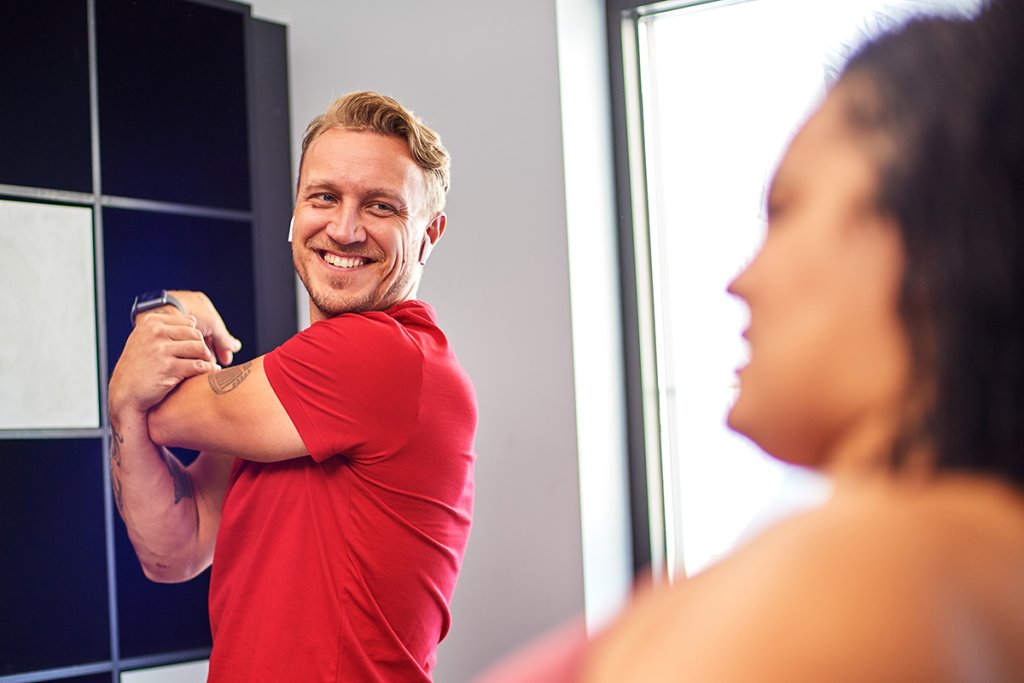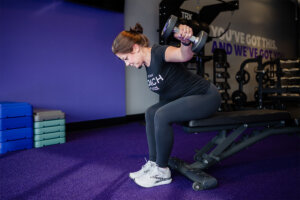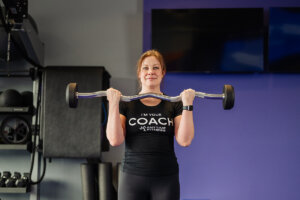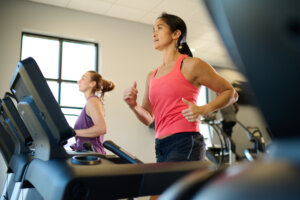You crushed your workout yesterday. Way to go! Today … you’re feeling it. But you have fitness goals to meet, and you want to keep going — we hear you! On the flip side, that soreness you’re feeling might be enough to make you want to stay on the couch until your next training session.
Stop and take a second to listen to what your body is telling you. What it probably needs right now is recovery, which is just as important as those high-intensity workouts you’ve been doing. Active recovery and rest days give the body time to repair, rebuild, and strengthen itself between workouts.
So, what are active recovery workouts, and why should you care? Let’s explore what active recovery workouts are, their benefits, and some examples that you can try yourself.
What are active recovery workouts?
Active recovery workouts are low-intensity exercises designed to help your body recover from more intense exercises — like those done during HIIT or conditioning workouts. These types of workouts are meant to be performed at a lower intensity, which allows your body to release tension and decrease muscle soreness.
Overexercising puts repetitive stress and strain on the muscles, increasing the risk of pain or injury. Active recovery can help keep blood flowing, which allows muscles to recover and rebuild from intense physical activity.
There are a few types of active recovery:
Active recovery during interval training
As part of your interval training (also called circuit training), it can be useful to have intervals that focus on low-intensity movements — or full rest breaks — that separate the higher-intensity exercises.
For many people, these intervals bring relief both physically and mentally, so you’re able to work harder the rest of the workout routine.
Active recovery as a post-workout cooldown
After a workout, cooling down is essential to a smooth recovery. That continued movement helps your body return to its pre-exercise state, and in some ways, you can view it as the first step to preparing your body for your next training session. A light cooldown should follow any workout, especially if the routine is higher in intensity.
Active recovery on active rest days
Rest days should be part of your overall weekly workout routine, especially if that routine includes more strenuous workouts. Learning to recognize when rest days are needed, and taking them at regular intervals, can help alleviate muscle pain, repair and build muscles, replenish energy stores, prevent injury, and allow the mind to rest. A rest day can be an active rest day, as long as the activities are gentle and low-impact.
How often you take rest days will vary depending on your personal routines, intensity levels, and more. A personal trainer is a great resource for helping you learn more about your body and what it needs.
Examples of active recovery workouts
There are several types of active recovery workouts you can try. They can include exercises such as:
- Stretching: Stretching between workouts can help you avoid injury and improve the performance of your next training session.
- Yoga: You get stretching, balance, and relaxation all in one low-impact routine.
- Light resistance training: Doing reps with very light weights can help with blood flow, supplying nutrients to the working tissue without straining them.
- Foam rolling: This helps release muscle tension and can improve mobility.
- Light cardio: Activities like walking, relaxed cycling, or swimming are low-impact and help increase blood flow and improve cardiovascular health.
Active Recovery vs. Passive Recovery
Efficient exercise recovery comes in two forms: active recovery and passive recovery.
- Active recovery: As noted above, this is all about staying in motion while you recover from higher-intensity exercises. Active recovery days — also called active rest days — are often more beneficial than inactivity or resting completely, although there are certainly times when resting has its benefits.
- Passive recovery: Alternatively, passive recovery means you’re at full rest. Your body simply relaxes in a still state, whether that be sitting or lying down. Passive recovery could include quiet down time, meditation, warm baths, getting a massage, and so on.
Benefits of active recovery workouts
First and foremost, active recovery days are actually the part of your training routine that make muscles grow bigger and stronger. That’s right: Muscle growth occurs during the rest and recovery process — not during the workout itself.
Additionally, active recovery training helps:
- Muscles recover faster: As your body begins the muscle repair process, inflammation in the muscles occurs, which can lead to pain and feeling sore 12–48 hours after a workout (also known as delayed onset muscle soreness). Giving your body an active recovery day allows your muscle groups the opportunity to begin to rebuild themselves.
- Reduce lactic build-up: Beyond blood flow, active recovery workouts help lessen lactic acid from your muscles. This reduces soreness.
- Increase blood flow: This improves blood circulation, which helps remove waste from the soft tissue that may have been broken down during high-intensity exercise. Nutrients are then delivered, which help repair and rebuild muscles, tendons, and ligaments.
- Keep your motivation up: Taking time for active recovery days will help you maintain your exercise routine in the long run by avoiding mental (or physical) burnout or injury from overexercising.
What good active recovery training looks like
Incorporating active recovery workouts into your routine doesn’t have to be daunting. Simply aim for one or two active recovery sessions per week, and listen to your body to determine what kind of exercise feels best.
Here’s a full-body active recovery workout to try. See how it feels, and adjust as needed!
Full-Body Active Recovery Workout
This active recovery workout uses light strength-training exercises. It’s important to note that if you’re feeling extra sore from your last sweat sesh, opt for a non-strength-training option and come back to this when you’re feeling less sore. Otherwise, let’s get into it!
Time: 9–18 minutes | Equipment needed: TRX, resistance band
Perform 3 rounds of the following circuit.
1. TRX Push-Up
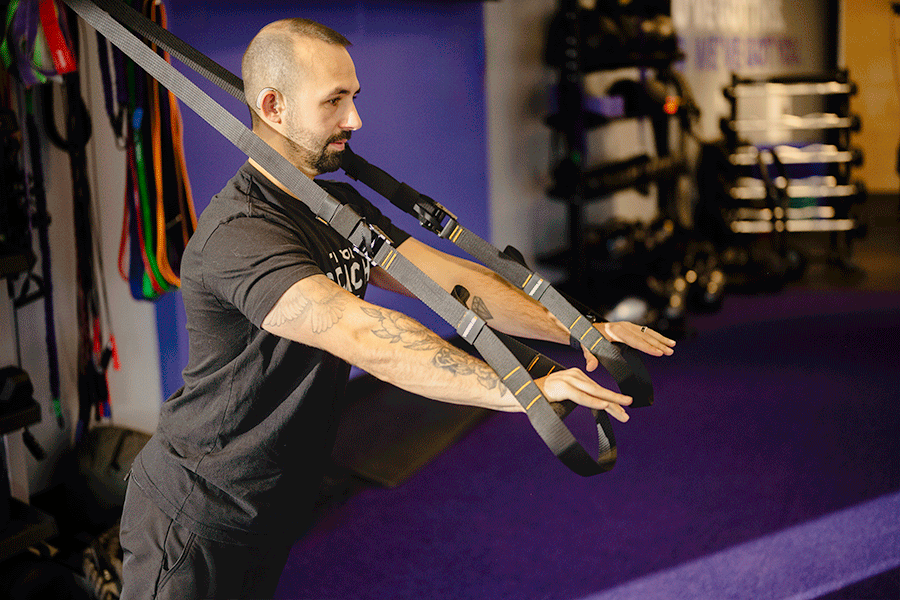
How to:
- Anchor the TRX straps to a stable object.
- Support your body with your hands in the handles, elbows bent, and legs straight out on your toes.
- Push up to a straight arm position, keeping your back flat and your hips in line with your shoulders throughout.
- Lower your body back to the start position, and repeat for 30–60 seconds.
2. TRX Squat + Row
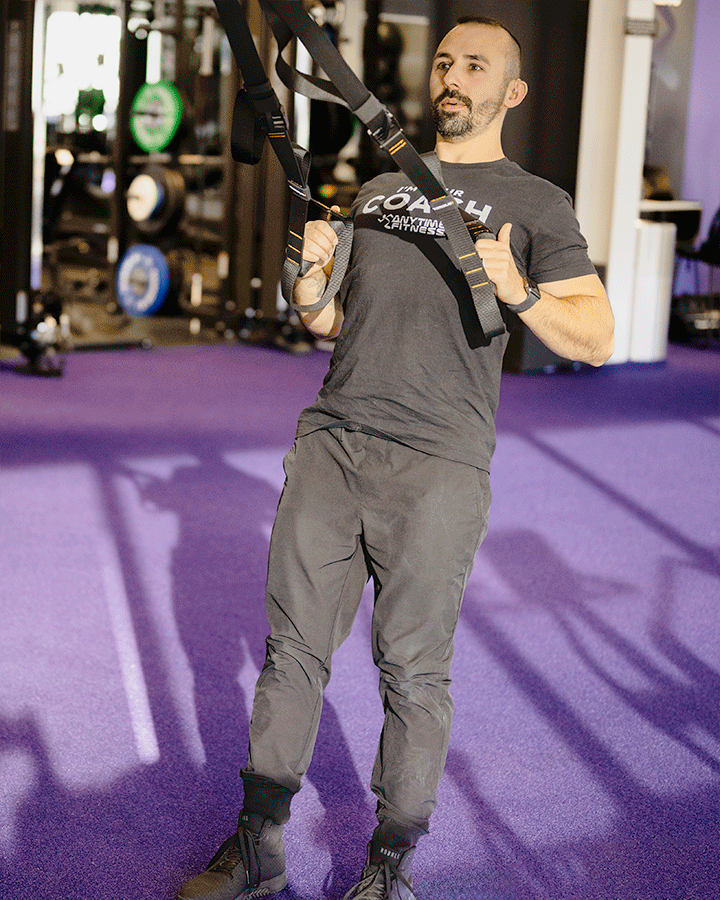
How to:
- Stand facing the TRX with your feet hip-width apart. Grip the handles, palms facing each other.
- Push your chest upright, and lean back until your body is suspended at a 45-degree angle with the ground.
- Keeping your core engaged, extend your arms and sit back into a squat position.
- Hold this position for two seconds.
- Shift your weight into your heels, and use your legs and lower back muscles to drive your body upward. Bring your shoulder blades together as you return to the starting position.
- Repeat for 30–60 seconds.
3. TRX Forward Lunge + Fly
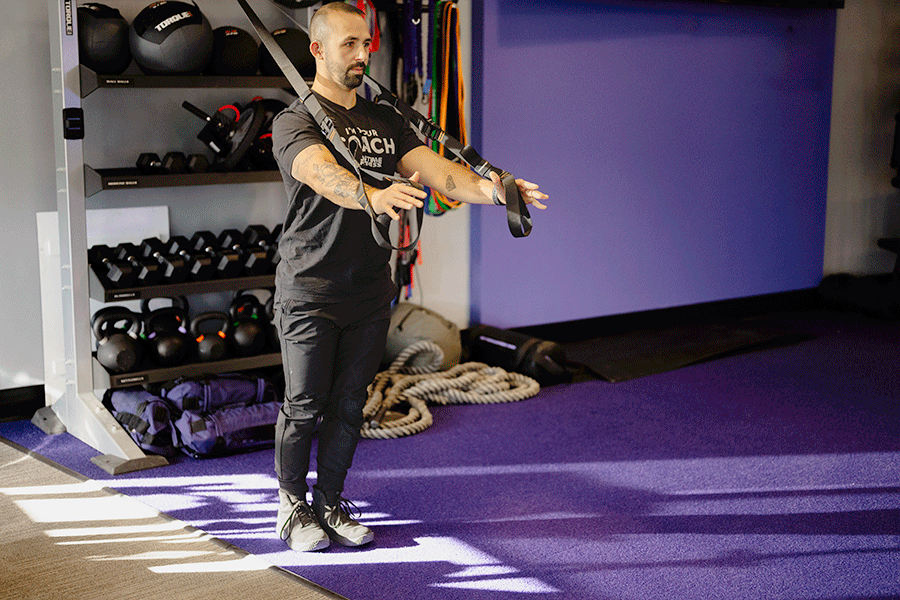
How to:
- Stand facing away from the anchor, and extend your arms at shoulder level with palms down.
- Take a long step forward and open your arms to a “T” position. Lower one knee to the ground with the other knee at a 90-degree angle. (You should feel a stretch in the chest and hip of the rear leg.)
- Step back to the start position.
- Perform all reps on one side for 30–60 seconds before switching to the other leg.
4. Straight Arm Pulldown
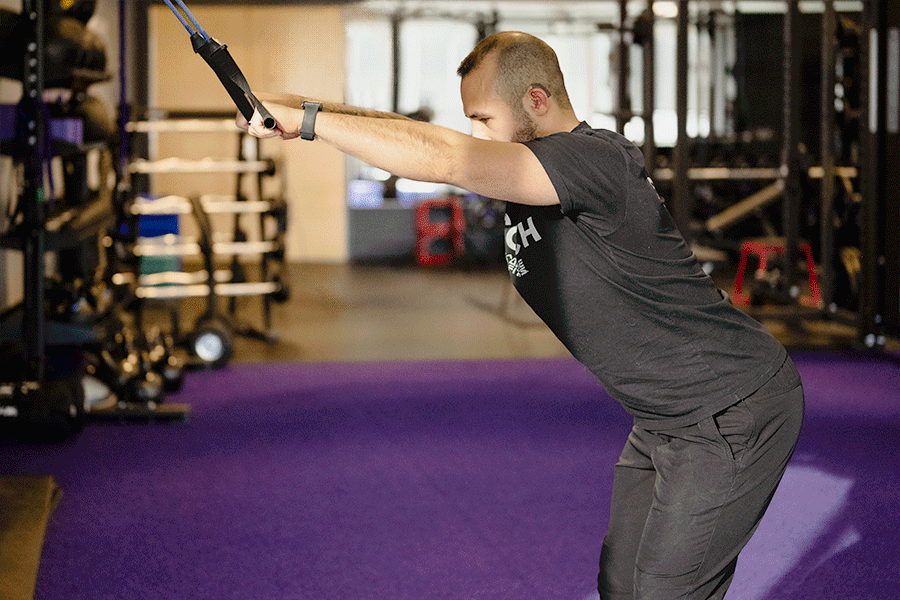
How to:
- Attach a resistance band to a stable object.
- Stand upright, and hold the handles with an overhand grip at roughly shoulder width. Lean forward slightly by hinging at the hips.
- Keep the elbows slightly flexed as you pull both handles toward your thighs.
- Release slowly to the starting position, and repeat for 30–60 seconds.
5. Band Anti Rotation Hold
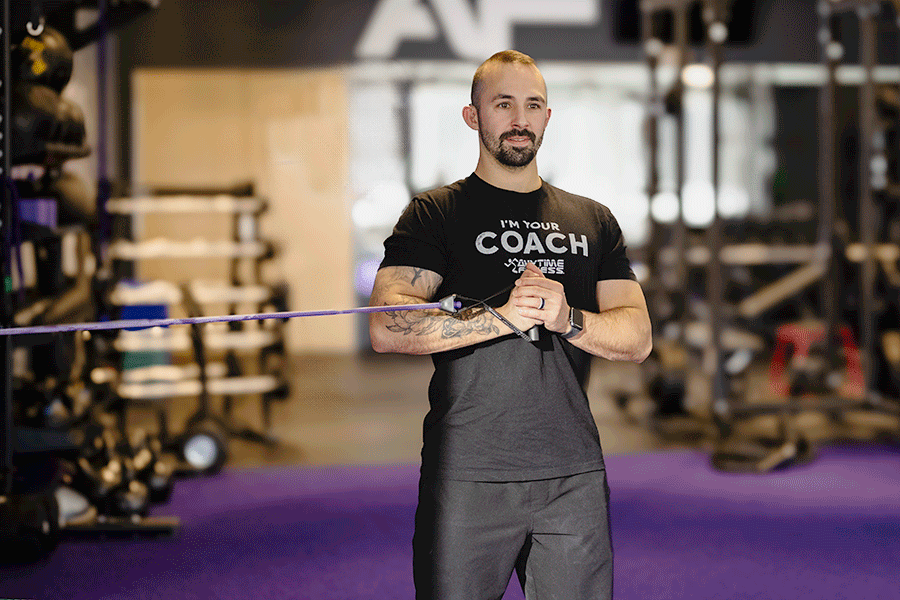
How to:
- Anchor one end of the resistance band to a stable object, such as a pole or rack.
- Hold the handle in both hands at your chest with your elbows bent and the other end of the tubing connected to a solid object off to one side.
- Press the handle out in front to a straight arm position while maintaining a stable upper body position.
- Return the handle back to the start position and repeat.
- Complete all reps on one side for 30–60 seconds before switching to the other side.
6. Plank
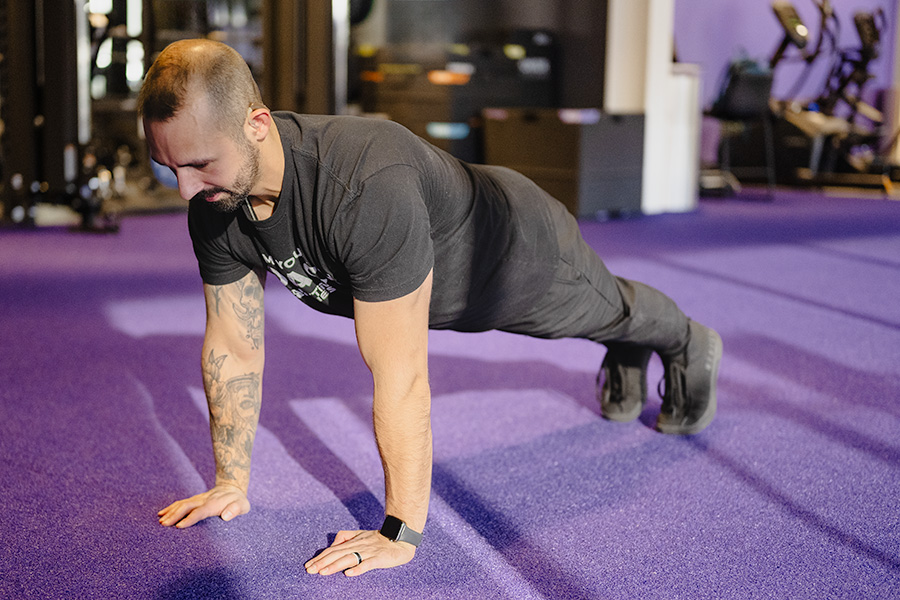
Modification: If a plank is too difficult, you can modify it by lowering your knees to the floor.
How to:
- Begin in the plank position, face down with your palms and toes on the floor. Your elbows should be directly under your shoulders and your forearms should be facing forward. Keep your head relaxed.
- Engage your abdominal muscles, drawing your navel toward your spine. Keep your torso and body in a straight line from your ears to your toes with no sagging or bending. Make sure to keep your shoulders from creeping up toward your ears. Your heels should be over the balls of your feet.
- Hold this position for 10 seconds. Release to floor. Repeat.
Takeaway: A final word on active recovery
When it comes to fitness, it can be easy to focus our attention on high-intensity, strength-training, and conditioning workouts, because it gives us the sense that we’re getting to our goals quicker. While these types of workouts are effective — and great for our physical and mental health — they’re also demanding on the body. That demand is good, and overtime, the body adapts to the effects of exercise. The key is making sure your training routines include regular active recovery or rest days. Doing so is vital to hitting the fitness goals that are most important to you.
Want more recovery content?
Whether it’s active recovery ideas or a gentle cooldown, we’ve got you covered.
- Foam Rolling 101: Everything You Need to Know to Get Rolling
- Why Recovery Is Essential — And How to Do It
- 7 Benefits of Taking Daily Walks
- The Best Cooldown Routine
- The Ultimate Guide to Post-Workout Aches: 7 Ways to Relieve Sore Muscles
- What to Do After a Workout: Your Ultimate Guide to Post-Workout Recovery
Knowing where to start when it comes to incorporating active recovery days into your weekly routine can be challenging. Find the AF gym nearest you and ask about the FREE fitness consultation and workout plan all members get, so they can start (or restart) their fitness journey off on the right foot.
